The Prado and the Avant-garde
Last year, using funds left behind by Clara Sánchez, the Prado Museum acquired María Blanchard’s La Boulonnaise, which depicts a shellfish catcher on the Strait of Dover in the English Channel. This purchase broke away from the timeline of the museum’s collection, which up until then had ended in 1881, the year in which Picasso was born. The piece by the Santander-born artist followed her Cubist phase. After the period in which her still lifes were confused with those of her dear friend, Juan Gris, the artist developed her own very personal style – portraits of assertive figures with a melancholy air. La Boulonnaise is a great example of this.
However, as my art teacher would explain during our monthly class visits to the museum, many of the Prado’s rooms do not give priority to avant-garde artists. If when I was sixteen years old I found it fascinating to listen to her explain the reasons why a painting was centuries ahead of its time, well now, as I wander around ARCO (which is currently open to the public in Madrid), I think about her and her extraordinary way of looking at paintings. Her name was Covadonga García Bueno. As I haven’t seen her for many years, this article – spanning four hundred years of history in search of the origins of Impressionism, Expressionism, Surrealism, Abstraction, and Conceptualism – is a tribute to her. By Ignacio Vleming.
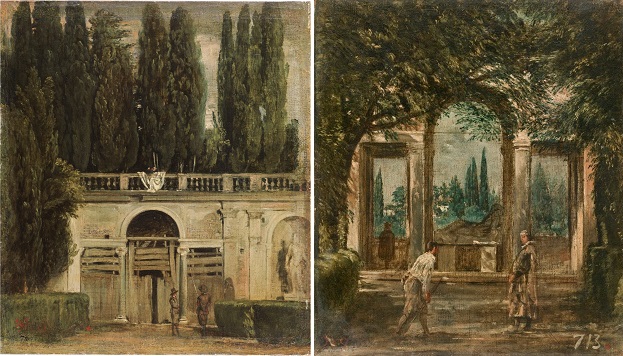
View of the Gardens of the Villa Medici, Rome, ca 1639. Velázquez, Impressionism.
Between 1629 and 1631, Velázquez visited Rome under the sponsorship of King Philip IV of Spain, who considered it essential that his court painter became acquainted with Italian style. It was in Italy where he discovered the work of Raphael, Miguel Ángel, Guercino, Lorena, and Bernini, and even met Ribera, or Lo Spagnoletto.
Following his experience abroad, his style changed dramatically. He began to favour nudes inspired by antique statues and welcomed shades of bright red, green and blue to his palette. However, while in the Villa Medici gardens, he also worked on two paintings that weren´t influenced by anything he´d seen before. Perhaps he painted them in a moment of rest, without the pretence of them one day being on display. Seemingly unfinished, the pieces look as if they were taken from his sketchbook. It´s even claimed that Velázquez potentially painted them outdoors, a practice that was rather unusual in the 17th century, anticipating the en plein air technique by three centuries, conceived in France by the artists of the Barbizon School.
What the artist most likely never imagined was that, when in 1865 Manet visited the Prado Museum, these very paintings would become a reference for the Impressionists, in the same way the Italian masters had been for him. In the delicate, spirited brushstrokes of these two small landscapes we can clearly see Monet, Pissarro, Sisley, and Renoir.
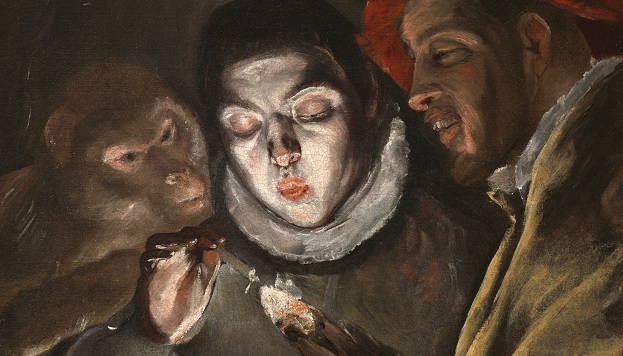
Fable, 1580. El Greco, Expressionism.
It is likely that this small work of art by El Greco is a nod towards a lost painting by the Greek painter Antiphilus, cited by Pliny the Elder in Natural History, in which he references the beauty of fire and the difficulties faced depicting this element. Nevertheless, this work on canvas could be said to summarise the characteristic style of this Cretan painter.
Here the source of light emanates from the burning embers a young boy holds between his fingers. On one side of him is a monkey, human-like in appearance, and on the other a man with an animalistic demeanour. The use of surreal, acid colours, thick brushstrokes, confusing textures — fabric that looks like rocks, rocks that look like clouds — and a richness visible in each object, as if each one was stirred from within, make El Greco a clear precursor of the various Expressionist trends.
Picasso discovered the work of El Greco in the rooms of the Prado Museum itself and became the painter’s true heir during his Blue Period. Members of Der Blaue Reiter (Kandinsky, Kee, Macke, among others) saw El Greco as their forefather. Russian filmmaker Sergei Eisenstein, director of Battleship Potemkin, wrote a marvellous essay about the artist. And Jackson Pollock considered El Greco as one of his greatest influences.
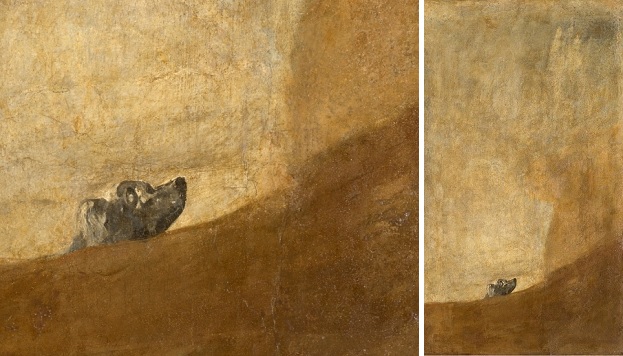
The Drowning Dog, 1819-1823. Goya, Abstraction.
Long before Picasso, Goya made giant strides in what was an intense personal journey towards his artistic culmination. Over a period of eighty years, he exhausted all types of artistic techniques. He started out influenced by the Baroque and as an admirer of Rembrandt and Velázquez; his tapestry cartoons took inspiration from the French Rococo; his The 3rd of May 1808 in Madrid, or “The Executions”, perhaps made him the first Romantic upon realising that heroes embody entire nations; his series of etchings, including The Follies and The Disasters of War, delve into the world of dreams and nightmares, just like the Symbolists would do years later; he also developed the psychological portrait and, what would be one of his last paintings, the Milkmaid of Bordeaux foreshadows Manet, taking its place among art more concerned with depicting feelings than capturing reality.
The Drowning Dog, one of the murals he painted on the walls of the house “la Quinta del Sordo”, is his most daring piece. So daring and revolutionary that, like the rest of his black paintings, it has been considered to be a fake on many occasions. Goya painted this piece, without any intent of profit, to keep him company along with the views from his home of the meadows of the River Manzanares. For decades these paintings were ignored. It wasn’t until 1878 that they would be displayed by businessman Frédéric Émile d’Erlanger at the third Paris World´s Fair. He later donated them to the Prado Museum in 1881, the year in which Picasso was born. The dog’s head – almost unrecognisable as a snout, one ear and one eye – is the only figurative element of the painting. Everything else (the sand, the air, the sky) forms part of an abstraction similar to the work of Mark Rothko, Tàpies, and Millares.
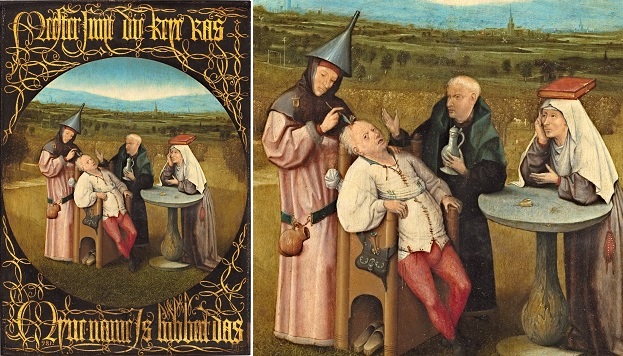
The Extraction of the Stone of Madness, 1494. Bosch, Surrealism.
Bosch was a surrealist before Surrealism existed. Or at least that’s what André Breton claimed as the leader of a movement that placed unconscious drive at the centre of art. When living in the Residencia de Estudiantes student hall in Madrid in the 1920s, from this group of surrealists, Spanish artists Salvador Dalí and Luis Buñuel discovered The Garden of Earthly Delights, The Haywain, The Temptations of Saint Anthony Abbot, Table of the Seven Deadly Sins and The Extraction of the Stone of Madness, an extraordinary series of wooden panels by this Flemish painter on display the Prado Museum, collected obsessively by King Philip II of Spain.
Researchers can’t agree on what it is that these paintings depict. Some scenes appear to allude to beasts, legends and medieval superstitions, whereas others make fun of ecclesiastic power, imperial authority and the bourgeoisie. The selected painting cites a Dutch proverb inscribed in Gothic script around the oculus which says: “Master, rid me of this stone soon. My name is Lubbert Das,” a figure in popular culture that represents folly. Although this may not be the only painting from the 16th century that represents this theme, the image of the funnel crowning the surgeon and a woman reclining with a book on her head, is without a doubt the most eloquent. The question is, who is the craziest of all?
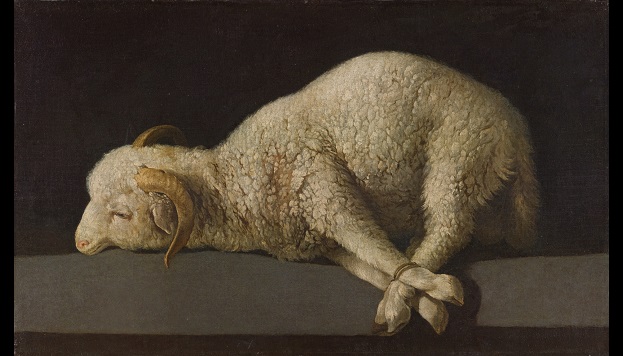
Agnus Dei, 1640. Zurbarán, Conceptualism.
Zurbarán is undoubtedly the most Spanish of all of the great artists of the Spanish Golden Age. When standing before his paintings, we can see that he did not care much for perspective or anatomical accuracy, two fundamental elements in Italian schools. This painter of monks and martyrs was more concerned with capturing the physicality of texture, volume and light than the theoretical precepts of treatise on painting. Zurbarán painted as though his eyes were two large magnifying glasses, capturing the essence of everything. His works achieved such spiritual elevation that they could almost become the objects they depict, while at the same time they could act as a symbol of the immaterial.
It is for this reason that his work has been reclaimed successively throughout the 20th century. His still lifes are a mix of conceptual pieces that always say more than they appear to at first glance. Agnus Dei is the mystical lamb, but also a lamb and nothing more. One of many, as though simultaneously a veiled reference to Saint Teresa of Ávila – “God walks among the pots and pans” – and a precursor of Magritte’s “Ceci n’est pas une pipe”.
And now, with my eyes wide open, I’ll continue wandering around ARCO, Madrid’s contemporary art festival, in search of the greatest masters of contemporary art.
